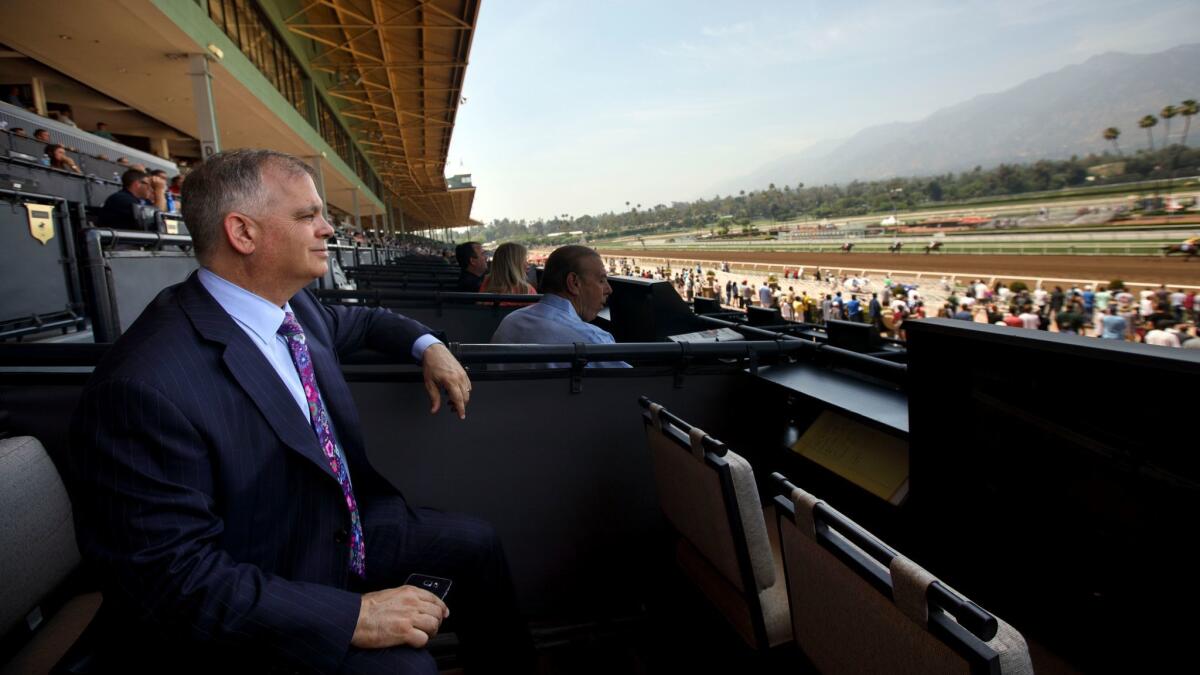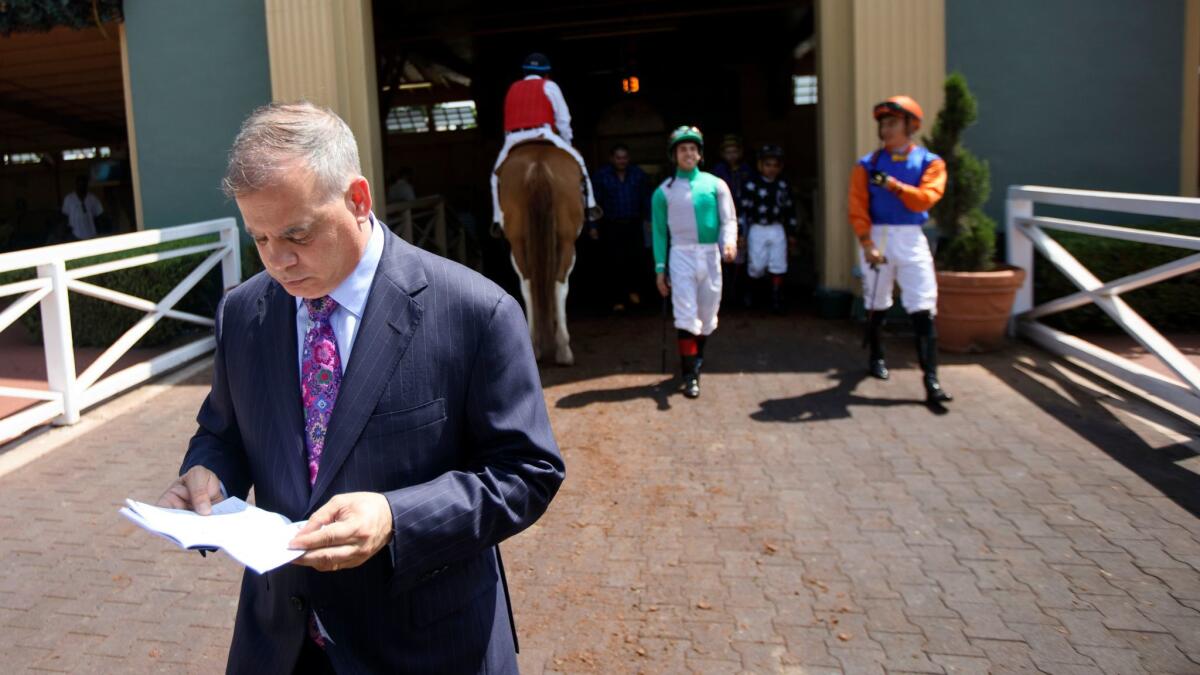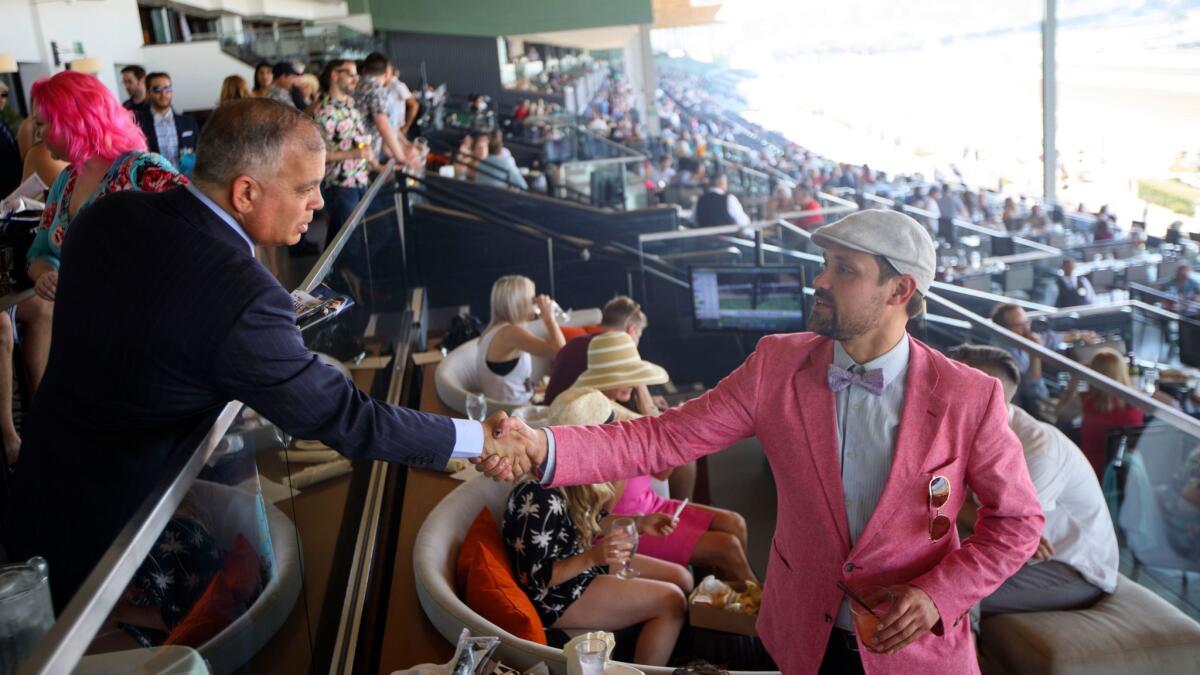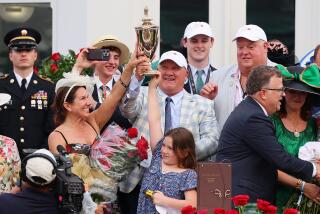Tim Ritvo tackles his biggest challenge yet: Revitalizing racing at Santa Anita

- Share via
Not to put any pressure on Tim Ritvo, but his job is easily defined: Save California racing.
The affable 52-year-old former jockey, trainer and long-time racetrack executive has been sent to Santa Anita to fix things. Ritvo has technically been in charge of Santa Anita and all other Stronach Group tracks since he was named chief operating officer of the racing division.
But first he had to fix Gulfstream Park in South Florida. Then he had to fix racing in Maryland. He’s two for two.
Now, he has his biggest challenge, revitalize racing at Santa Anita.
The problems at Santa Anita are well known. On Sunday, the track announced the cancellation of racing on Thursday because of a lack of entries. It’s the second time this year. It underscores what Ritvo is facing.
In his first extensive interview since coming west two weeks ago, conducted a few days before Sunday’s announcement, Ritvo sat in his rather ordinary office on the first floor of Santa Anita and outlined what he saw as his mission.
He pulled his chair from behind his desk and started talking — fast with no pauses. He knows his stuff, speaking at length with confidence, backing comments with facts.
He continually folded and unfolded his collapsible glasses by reflex and wasn’t afraid to talk about difficult topics. The questions and answers were edited for both clarity and brevity.
Why are you a good choice to revitalize Santa Anita?
When [Stronach Group founder] Frank [Stronach] tapped me on the shoulder to run the company, he said: “We have a lot of work to save an industry that is struggling. And you’re going to be the bridge between corporate, guys with MBAs and lawyers who don’t understand the first thing about racing. So I need a guy like you to help these guys understand the whole concept of racing from the bottom up.”
We had a lot of success in Florida, where the pari-mutuel handle has just sky-rocketed. And in Maryland, where we take a subsidy from slots, to regenerate the whole mid-Atlantic. California, unfortunately, as great as it is, doesn’t produce enough revenue for the Stronach Group for its property value. It’s so important as future generations of Stronachs come along, that if property values aren’t returning dividends, then someday, someone won’t love racing as much as Frank and we won’t see racing here.
It would be devastating to California if we lost Santa Anita. My goal, my objective, is to put it on a healthy foot so that the percentage of return on property values is good enough to not have a discussion of anything else.
What is the biggest problem here?
[Bettors] want lots of options and they want field size. They want field size even more than quality. Now, I don’t want people to think all we’re going to do is run cheap racing because these great races and great horses are very important to us. But people like to bet a $16,000 maiden or a $16,000 open race on the grass with 14 horses so they can play a dollar trifecta box and come out with a $400 or $500 payout rather than a six-horse field and get no value.
So, the No. 1 thing I think is field size. I don’t put all the blame on the horsemen; we have to take our fair share of the blame. Whether it’s the racing schedule or we’re not writing the right races or we don’t have the right inventory.
We don’t really believe there is a horse shortage. You can produce more horses in a couple years very fast. We believe there is an owner shortage. How do we get more owners in the game and keep them longer? It’s a tough business. There are much better things to invest in for profits. But as a guy who has been in this business all my life, there is no greater enjoyment than raising a horse and winning a race with them.
You say there is an owner shortage. Would a good first step be if Frank Stronach would move some of his horses out here?
He’s open to it. About two years ago, when we were exploring to come out here, we looked at some of the farms here that we could breed some horses and have some inventory here.
But we can’t depend on just one person, Frank, saving everything. We need to make sure we make this a healthy industry for every person — the breeders, owners, trainers, jockeys and race-track owner.
But the economic engine is the guy betting on us. So we need to give that guy a quality product at the highest level of integrity so they feel comfortable calling it “investing” instead of “gambling.”
Are you satisfied with the state of the barns at Santa Anita?
No. The barn area is a touchy, touchy subject. It takes a huge amount of investment to maintain it and to upgrade it and there is no [return on investment]. It’s a long-term play.
For sure, new stabling has been talked about. Now we’re going to dig in and take a look at that, but we need a long-term commitment that makes sense. If we are going to be the majority of racing dates and the majority contributor, then stabling and vanning funds, the [simulcast] model all need to be looked at again. Some of the siphoning off of revenues would go back into the purse structure, back into the brick-and-mortar facility, if there is some restructuring in place.
Obviously, we would like to have new stabling, but you don’t go in and invest heavily in barns if you don’t know what your future looks like.
Is one possibility to build new barns in the parking lot behind the track and sell off the Baldwin property?
There are lots of possibilities. One would be [to join with] the mall like at Gulfstream where the park becomes part of the whole entertainment component. You could maybe move the barns to the backside or even off the property, if you could find a place that accommodates training.
If you look at the Gulfstream model, that property has become so valuable that there is the possibility of making it a shipping-only meet and building hotels and condos at the site.

Laurel [Park in Maryland] has a train station that goes right through the property. How do we develop that properly and learn from the mistakes we made at Gulfstream? We built a building that’s a little bit too small. It’s great 364 days a year, but when you try and have that big day, you can’t do it.
Obviously, the history and culture of this structure is magnificent. What we want to do is figure out how to incorporate the beauty that this place has and to utilize the facility for multi-purposes. Racing would be the core business of the Stronach Group, but how do you multiply the entertainment component so we can mix this all together without it becoming a circus?
How long do you think you have to fix this before looking at other options?
I’d hate to put a timetable on it, but I can tell you that the facility is underperforming based on the property value. This place is worth, at a minimum, half-a-billion dollars. We don’t get anything close to 4 or 5% back. They are not greedy people, they just want to get a fair investment so they can justify to future generations that it makes sense to race here.
Is the fact that the track is underperforming an indictment of the people currently running it?
I would hate to say that because the people here are passionate. I think fresh eyes can help. Instead of saying that’s the way we’ve always done it, I’m going to be a guy that goes to the TOC [owners], the trainers association, the breeders. Most people are acknowledging that we are underperforming, even from the horseman’s side and everybody else. Everyone is struggling trying to figure out the answers.
Before I blame anyone here, I walked around and found passionate people. But sometimes you get in a zone and need some advice from outside. [Stronach Group Chair and President] Belinda [Stronach] thinks that even though we’ve grown market share, the entire industry is underperforming and we should be doing a better job on the sport.
I believe life is in three parts. Zero to 25 you develop your skills, figure out who you are going to be, go to school, you’re a plumber, electrician, a racetrack guy. Then from 25 to 50, most people get married, have a mortgage, have kids, you’re trying to put them through college. And 50 to 75, you’ve got discretionary income.
So from zero to 50, how do we give them multiple opportunities to come out here and have a really cool experience and have them ask how they can do it again. I’m such a firm believer in grassroots.
When I fly and tell someone I work at a racetrack, the first thing they say is, “Car racing?” And I say no and then give them my card and invite them to lunch at the track. The overwhelming response is not that I bought them lunch, it was that they didn’t know we were here. This is amazing. What a day. And they bring their friends. If everybody who works for us did that, we’d be a more growing business.
What other ideas are on your plate?
In a lot of our facilities, we’re looking at how do we go admission-free. Maryland is free. Gulfstream is free. We’re seeing a lot of people coming and the per capita betting going down, but we’re OK with that because we believe when you win a race as an owner, you want to see a lot of people cheer for you.
Frank has put hundreds and hundreds of millions of dollars into racing. I just want people to understand Mr. Stronach has never taken a penny out of racing. He’s contributed, contributed and contributed, whether it’s the breeding industry or this side of it.
If you struggle as an owner, you can buy fewer horses, cut your stable down from 10 to five. When you own these facilities, you can’t just shut them down. We have to try and run more of the inventory and make sure the purse pool and customer base is there.
Growing the business is what I want to do. Anyone can come in and cut a bunch of people out of the staffing, make the experience worse and worse. But then we’re going on a downward spiral. It’s just a matter of time. We need to grow the business. We need to grow the entertainment part of it.
Are you going to change the distance of the Pegasus because it’s almost impossible to win at 1 1/8 miles from outside posts at Gulfstream?
We’re looking at a mile and 3/16ths.
The way we have it structured at this time is last place gets $650,000, so if you have a horse and finish last, you lose only $350,000 [of the $1-million buy-in.] What we tried to do is the top four make money, the middle four come very close to breaking even and the bottom four lose a little bit of money.
The concept was not to make money. The concept was to have another great day and keep horses in training longer. And now you can come from Breeders’ Cup Classic to Pegasus Cup to a Dubai World Cup. If someone else does one somewhere else in the world, there is a purpose for not going to the stud barn and run another year.
Is there a model where you centralize more of the racetrack functions?
We operate on both coasts and the first model is how do you centralize racing offices on the East Coast and the West Coast at first, and then maybe a totally centralized national racing office that small mom-and-pop tracks that struggle can use as a service to them.
It’s not just about consolidating and saving money, although that’s an important factor for the longevity of racing. But it’s also to bring integrity to its highest level. We have a lot of super trainers, who have these huge 200-horse outfits. Are they good for the game? A lot of us would argue no. Those guys that have them have worked hard. They’ve developed great skills and they are great guys.
But how does a smaller guy get started if the owners are giving all their horses to the same guys? Let’s face it, if you have a 2,000-horse population, are you better with 25 trainers or 100 trainers? We’re better off with 100. Why? Because rather than having 20 2-year-olds, not willing to run them against each other, this population would get spread out. All of this needs to be looked at for the survival of the sport.
Everybody that owns a horse wants to run in a five- or six-horse field, including myself. Everyone that bets on one, wants a 10- or 12-horse field to get real value. Most horsemen know we have to grow field size for the customer.
How do you get to keep the horses stabled at Santa Anita to run here rather than ship elsewhere?
We need to look at that. That’s a problem. Arrogate trained here; he’s the jewel of California racing right now. He’s the world’s best horse in the rankings and he’s not going to be able to race [at Santa Anita] because there is not a race for him. Those things I struggle with. We’ll have to figure it out.
Maybe one day the Pegasus World Cup comes to California and horses like him will get an opportunity. How do we have these super event days at all our facilities? Without the Pegasus, Arrogate would have never seen Gulfstream Park. He’s not coming in for the Donn Handicap.
Maryland has the Preakness and that’s a big day. Gulfstream has the Pegasus World Cup and we have the Santa Anita Derby, but we have a lot of those and it’s not at the level of what a world championship race should look like. Obviously, when we have the Breeders’ Cup here, California residents, fans and customers are fortunate enough to see a great caliber of racing.

Is a three-day race week on the table?
Yeah, everything is on the table. When you look at a three-day week, you can look at it in many ways. I look at it as racing opportunities for my owners, horsemen, trainers to stay healthy. Also the fans and customers.
How can I give them the best experience? Is it four days a week, eight races a day? That’s 32 races. Or is it 10, 10 and 12? It’s the same 32 races. But do we have more eyeballs on the product on Friday, Saturday, Sunday, when people are off work and going to the track? Or are we better trading our eight races on Thursday and replanting them in different spots?
It’s not about consolidating work staff or anything else. It’s to make sure I can put more people in the stands to enjoy the experience, and if I’m trading a Thursday to run a couple extra hours on Friday, Saturday and Sunday, and I know I can grow my per capita, then we’ll look at that model.
Is it more likely or less likely you’ll go to three days?
At the first look, I’d say it’s more likely that something like that can happen. Obviously, with the cooperation of the [California Horse Racing Board], because they are supposed to look at what’s in the best interest of racing, we like to lay everything out on the table.
You have to look at what’s best for the majority of people in the industry. We are at a very, very critical point. Is the property worth more as a real estate development or a racetrack? And I’m going to do everything I can, with the cooperation of everybody involved, to make sure I can prove that it’s worth more as a racetrack.
You put a $30-35-million statue of a horse — Pegasus — in the parking lot of Gulfstream. Is that the best use of that money?
The truth of it is Frank Stronach worked very hard his entire life, he’s been very successful. He’s an American story. He can do pretty much whatever he wants to do with his money.
In his heart, he actually believes it’s a monument to racing. He believes the Christians go to Rome to pray, the Jews go to the Wailing Wall and the Muslims go to Mecca and that horse players will come to Gulfstream Park because this is a monument to experience.
I’m sure there are people who think the money could be spent better. Frank believes it’s iconic. It’s something that can’t be duplicated.
[You could put the money into purses], but purses … and horsemen will go crazy when they hear this, are not indicative of success. [New York Racing Assn.] has all the purse money in the world and their field size has not improved; $100,000 maiden special weights struggle every day. I do not believe that people who are going to sales and buying million-dollar horses care if maiden special weights are $60,000 or $100,000 when they spend a million dollars for a horse. What they are looking for is the development of a horse to win graded races.
The everyday guy, of course, that extra $40,000 helps, keeps him in the business a little bit longer and helps pay the bills. I don’t think solutions are taking money and throwing them into purses. I think we’ve seen that in slot-filled jurisdictions. They’ve taken a lot of slot money and thrown it in purses, but not cared about racing, and we’re seeing that money being pulled away and the handle not growing.
A lot of time we raise purses and trainers go up on their day rate.
How long are you going to be here?
I don’t know. I’m the kind of guy who loves the business. This is a dream job. I just get up every day and thank God for the opportunity I’ve been given to work in a business that I feel I can contribute to. I’m still going to look over all the other tracks.
So we got Florida going and we got Maryland going, great people in places there. We got great people here. I just want to give them the understanding what corporate is looking for, what I’m looking for to make Frank happy, to make Belinda happy, to keep this thing alive.
This is a big job here. It’s the biggest job I’ve been handed. One downside here that I didn’t have at the other places is that Frank gave me the tools to be successful. At Gulfstream we built a brand new racetrack with a huge grass course and at Laurel we built a brand new racetrack with a huge grass course. And I’ve already talked to him about how can I increase my grass course here.
For some reason, people are betting more and more on grass racing. The field sizes are bigger. The horses are more competitive in the end, so that has to be looked at in the 10-year plan.
I think all this takes time, so if I have to be here for years, then I’ll be here for years.
Twitter: @jcherwa
ALSO
Somehow, in horse racing, the show (bet) still goes on
Stellar Wind wins thrilling duel in Beholder Mile
More to Read
Go beyond the scoreboard
Get the latest on L.A.'s teams in the daily Sports Report newsletter.
You may occasionally receive promotional content from the Los Angeles Times.











